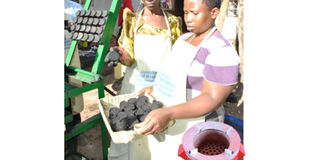Charcoal made from banana peelings

Women from the community display some of the briquettes. The mixture is pressed in a machine to form the shape of briquettes.The finished product burns up to five or six hours unlike charcoal that burns only an hour or two. Inset, the Briketi stove emits less smoke and can be used both domestically and commercially. Photo by Racheal Ajwang
In Bwaise, a Kampala city suburb, some individuals collect banana (matooke) peelings from the surroundings in their community. Ordinarily, this is garbage that is all too familiar in a community where matooke is a staple food, but not to members of Peace Development Group.
The peelings that have been thrown away by different families are the valuable raw material the group needs to transform their lives and conserve the environment.
Finding a new life line
These peelings are converted into briquettes and used as largely domestic fuel instead of the all too common charcoal.
“After collecting the peelings from people’s homes, we remove any rubbish residue in them including leaves. Then, spread the peelings under the sun for hours until they are dry,” Prossy Nankungu, the group treasurer, says. The dried peelings are then burnt in a drum until they become ash.
Once ready, they are poured into another vessel and left to cool.
“We then add a bit of cassava flour, already mixed with water, to the crushed stock to help it stick together,” Nankungu says, adding, “eventually, we pour the solution into a machine which helps to partition it into balls called briquettes.”
Their charcoal machine maker has a capacity of making about 24 briquettes per round. Twelve briquettes go for Shs1,000. Nankungu says most of their clients are members of the community.
Doing away with deforestation
The process of making the briquettes requires specialised skills, no doubt, an aspect that gave birth to a bond with a social enterprise that shares the community’s vision.
For the last couple of years, Green Bio Energy Ltd (GBE) has engaged communities such as these and trained them on how to effectively and efficiently make briquettes.
The company either invites groups to their head offices in Bugolobi, Kampala or visits their workstation. Besides Bwaise, other communities are in Namuwongo, Gayaza and Kawempe.
This conservation journey for the social enterprise begun in 2011 when two French nationals, Vincent Kienzler and Alexandre Laure, acted on their passion to tackle issues of deforestation and climate change. “The majority of the population in Uganda uses wood and charcoal.
After spending some time in Uganda, travelling, observing and discovering, they went on and started developing energy-saving solutions and technologies,” David Gerald, the deputy managing director, GBE says.
The inspiration for making the briquettes was to serve as a substitute for the firewood and charcoal that people were using which had disastrous effects on the environment. With a background in engineering, Kienzler designed and developed the machinery from local material.
Data compiled by the World Resources Institute reveals that the planet has already lost 80 per cent of its forest cover to deforestation. Uganda had more than five million hectares of forest in 1990, but only 3.5 million hectares remained by 2005.
The National Environment Management Authority (NEMA) warned in its State of the Environment for Uganda 2008 that if deforestation continues at the present rate, Uganda will have lost all its forested land by 2050. It attributed the rapid rate of deforestation to expanding farmland, rapid population growth and increased urbanisation.
Production for a wider market
The founders of GBE believe that replacing wood as fuel will significantly tackle the deforestation issue. Currently, the company produces and distributes briquettes made of organic waste and residue to a wider market at an affordable cost.
Their training programme enables them control the quality of the briquettes produced in the community. The production house is located on Bukerere road. On a Tuesday afternoon, a loud noise emerging from a machine is the first thing I hear as I make my way to the vicinity.
“The most important raw materials we use are charcoal dust and dried banana peelings which we carbonise before eventually compressing it to a finer powder for making briquettes. We use cassava flour solution which helps in binding and maintaining the briquette as a block.
Our main challenge is that we sometimes face technical difficulty due to the nature of the machinery as it is made from local material thus not so durable,” Gerald explains.
Energy efficient stoves
In 2013, GBE also started manufacturing and distributing improved cook stoves that are slow burning. The stoves are designed to reduce the quantity of either briquettes or charcoal used for cooking, hence reducing fuel consumption.
The other advantages the stoves come with include emission of less smoke hence reducing the occurrence of respiratory illnesses. Today, GBE produces about 35 tons of briquettes and 2000 stoves per month.
The briquette products are sold at different outlets including grocery shops, supermarkets and petrol stations around Kampala and Mbale from as low as Shs1,000 (less than a dollar). A 7.5Kg bag costs Shs7, 700 ($2), 25Kg bag is Shs19, 500 ($6) while a 50kg bag is Shs37,500 ($11).
Juliet Nankya, a grocery dealer in Nakasero Market, who has used briquettes for the last three years hails them for burning longer than charcoal. Briquettes can burn for five to six hours.
Despite this advantage however, according to Gerald the wider population still requires awareness on this alternative fuel. He believes penetrating communities like is currently being done to create awareness and train will go a long way to spread the use of briquettes.
The Daily Monitor, Uganda




